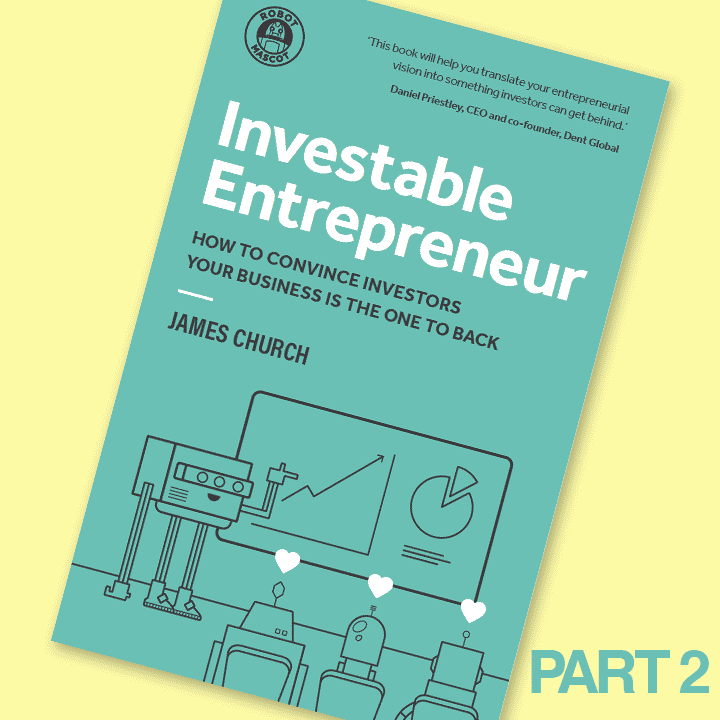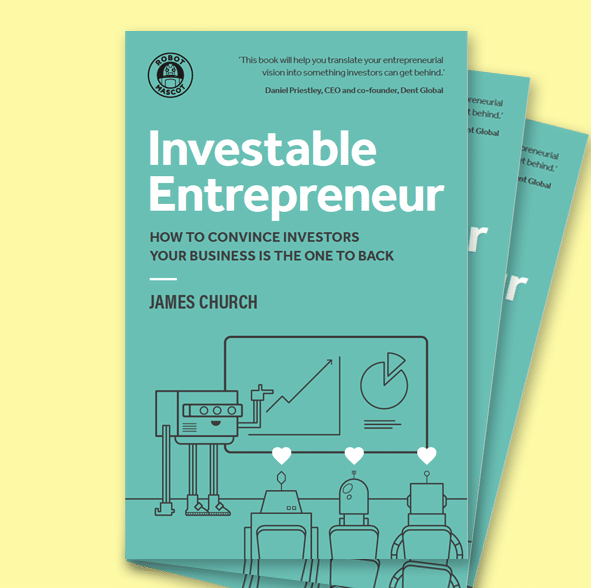Are you an Investable Entrepreneur? Book Interview, Part 2: Action
3 Keys to Securing Investment
An interview with James Church on his book for founders seeking investment
In Part 1 of this interview series with James Church, author of Investable Entrepreneur, you’ll see how to lay the groundwork before the pitch and how to get into the mindset of an investor to better increase your chances of securing funding. With preparation handled, James shows you how to put this preparation to action as well as the reality of the investment process.
THE IMPERATIVE THREE P'S IN GETTING INVESTMENT
James has identified 3 P’s in his process at Robot Mascot when helping founders to pitch. It all starts with demonstrating your ability to get people to buy into your vision. We look at how to show you understand the financial risks of a start-up. As well as, communicating a focus on your long-term mindset.
MW: What are the three p’s to getting investment?
JC: They are the three critical fundraising assets that I outline in the book. Which are the Pitch, the Projections and the Plan. So they’re the three key fundamental assets you need to effectively communicate with investors. The reason you need these three is that they talk to different parts of the investor’s brain. It’s as though investors are looking for three checkboxes to tick, in their list of the ideal founder, to be able to invest.
THE PITCH

The first asset is that you are highly resourceful. You’re able to get people to buy into your vision. You can get people excited by the concept.
Not only can you raise capital when you need it, but you can attract great talent into the business. You can get individuals to work for you at a below-market rate, in return for some equity. This is because they really believe in the vision and want to be part of your journey.
The same with advisors. You can attract these really high-level advisors to support you because they believe in your vision.
You have the ability to bring on board, game-changing partnerships with large brands which have a knock-on effect. It gives you access to a whole new network of potential customers. These customers want to support the business as they have also bought into your vision.
Investors are looking for a founder who can achieve all of the above. In order to do that, the first checkbox is a great pitch. This ‘great pitch’ is what will get people to buy into your vision. Once investors see that other people are excited about your vision, they know many others will be as well.
THE PROJECTIONS

The second asset is a founder with a clear financial understanding. Not someone with just an understanding of the financial rewards.
Founders love to focus on the future revenues of the business. But, investors want to see someone with financial maturity. Show that they understand the financial risks, how to manage the finances, and how to mitigate those financial risks. The best way to show this is through a solid set of financial projections.
In the projections, investors want to be shown not just revenue, but clear metrics and ratios. This shows that you’ve got credibility in terms of the amount you’re spending and how you’re spending it.
Your cash flow is showing that you have a cash buffer. That means that you always have a spare capsule for any delays at any point. You’re not going to have to lay off that team you just spent 12 months building because your next round of investment was delayed by three months. You’ve built in a three-month cash buffer and have ways and means of managing that money sensibly. You need those projections to do that. That’s the second checkbox.
THE PLAN

The third and final asset investors are looking for is a founder who understands how to create commercial success.
So that’s flipping from, “I’ve got this great idea and everyone’s going to love it” to:
• “How do we actually make that happen?”
• “What are the stepping stones in the short term?”
• “How we get to our next big strategic goal with the money that you give me right now?”
• “What’s our long-term plan to get from where we are today to a potentially high-value business?”
• “How do we achieve multi-million pounds exit and deliver a massive return on investment to both the founder and also their shareholders?”
In order to do that, you need a business plan that details the strategy for achieving your short-term and your long-term aims with the company.
We know the plan, for early-stage startups, is going to change dramatically over the course of the next five years. You’ll probably pivot three or four times during that period. But, the point is to show an investor that you understand what your current long-term goals are so that they have faith in you. The investor gets to see that you think long-term. Show that you understand some of the details along that path may change because of different opportunities that come along.
As you go through the process, you learn more about your product, your client, and the product-market fit. And there might be new opportunities that take the company in a completely new direction. But it’s about showing your ability to think about growth or scaling a business. This gives them faith that they’re backing a founder that they can trust. And that’s the final checkbox.
REALITY CHECK
With the 3 Ps in hand, entrepreneurs may think it is smooth sailing from there. But, James makes it clear that reality is quite different from what startup entertainment media may lead us to believe.

MW: You did touch on this difference between reality and what’s been made rosy through entrepreneurial culture on social media.
From a branding perspective there’s definitely a difference between reality and shows like The Apprentice and the real world. Alan Sugar is expecting the entrepreneur to come up with everything themselves as he is looking for a well-rounded individual.
With this misguided expectation, the entrepreneur can then go to a branding agency and dismiss their expertise, trying to lead. This will result in them not getting the best use out of the agency’s knowledge because of the expectation that they have to do everything themselves.

Money on the table – Shark Tank, US vs Dragons Den, UK
From your perspective is there a difference between investment shows like Dragon’s Den and reality or can business founders actually learn from these types of shows?
JC: There’s definitely a difference. We’ve got to remember that Dragon’s Den is made for TV. There’s often a perception that you’re going to pitch a business to an investor, and they’re ready with a stack of money on the table. And they’re just going to say, “yeah, I want to invest” from the pitch. What you don’t see in Dragon’s Den is the number of deals that seemingly happen on TV but then fall through offscreen. As they leave, they go to their legal teams. They start drawing up the contracts and doing their due diligence. And the majority of those that get investment on the show never actually get invested in at all.
The reality of the situation is that you’re going to pitch to an investor. But they’re not going to make an instant decision about investing as soon as you’ve finished pitching. What you’re doing is, you’re pitching for them to invest their time, not their money at that stage.
You’re pitching for them to want to sit in a second and third meeting with you to understand the business in more detail. Then in the next stage, they go through that due diligence process. For a larger fund, due diligence is followed by a legal process. Additionally, there would also be an agreement on heads of terms and shareholders agreements.
At any point, an investor can say, “This isn’t for me. I don’t agree with what you’ve got as a structure to the company. It doesn’t work for me. It turns out that what you pitched isn’t quite the reality. You haven’t got as much traction as you made me believe in your pitch. I’m not going to invest anymore. I don’t agree with some of these terms in the shareholders’ agreement. I’m pulling out…”
Until the legal documents are signed, there is absolutely no commitment for an investor to put any money into your business. This is why I talk about these three P’s and having all those things in place.
A lot of founders are able to pitch really well. However, they don’t necessarily close investment rounds. This is because the pitch isn’t built on a credible financial forecast rendering the business plan, not believable. They haven’t got the things in place to go through those second and third meetings or that due diligence phase to get the investor over the line.
There are lots of people pitching really well but not closing deals. No one’s going out there pitching just to get more meetings with investors and no money. Think about the long-term process. Don’t have it in your head that it’s like Dragon’s Den where you’re just going to go pitch and they’re going to say, “I love it, here’s my money”. That is far from reality.
CONCLUSION
There are three main assets to secure investment. As demonstrated by James, they are; an effective pitch, detailed projection, and the long-term plan for your start-up.

Here are some handy tips you can follow:
1. Sell your vision: As a successful salesperson, express your ability to persuade people to buy into your vision in your pitch. Sell your inventiveness. Sell yourself with your enthusiasm. Sell your company’s ability to recruit great talent, high-level advisors, and game-changing partners.
2. Show your financial maturity: A solid projection will demonstrate a thorough awareness of the financial risks as well as the financial rewards. An investor wants to see that you understand metrics and ratios, not just revenue. Look to demonstrate your credibility as a mature founder, by presenting the amount you’re spending and how you’re spending it.
3. Be Pragmatic: The plan should show your ability to generate commercial success. Show you understand how dramatically markets can change over a five-year period. Acknowledge that the company may need to pivot numerous times. Demonstrate your approach to achieving both short-term and long-term goals with the company. If you want an investor to believe in your vision, specifically outline your current long-term objectives.
We discussed the importance of the three p’s that help you get investment. But then, how do you visually show your new approach? In the next instalment, we’ll discuss how design plays a part in your pitching process and helps you to stand out. Stay tuned for part 3.
If you’re at the stage where you are seeking investment, use these three pointers to plan a successful pitch by yourself. Or if you need further help, snap up Investable Entrepreneur.
—
If on the other hand, you’re a founder who successfully secured investment and you need help with your brand strategy for your brand, get in contact.
The day has arrived...your new freshly baked web designs, hot from the design...
If a guest asked for toast, would you butter a piece of bread...
In our last article, we looked at how brand purpose can be a...




